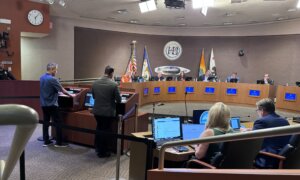Low-performing California schools must now give the state detailed plans for improvement to qualify for some funds, according to new guidelines by state officials.
The changes require public school districts to devise plans for their individual low-performing schools and charter schools to address poor student performance and how they will target future funding for improvement.
Districts will be required to include such plans in what’s known as their Local Control Accountability Plan, a document they create to set goals, plan actions, and distribute resources to improve academic achievement.
Previously, state law only required improvement plans from a district as a whole, not individual schools. The changes were approved at a California Education Board meeting in November.
Low-ranking schools on the California School Dashboard—which measures schools’ academic performance—will now be required to set specific goals to improve academic scores for students, and to achieve them.
It also requires schools to set milestones to gauge whether those strategies are effective in three years, and what to do if not.
The changes were met with some controversy from local district and school officials, however, who told state board trustees at a November meeting that the changes would create a heavier workload for administrators and make accountability plans “unreadable.”
“In my experience, every addition of a new table or box or checkbox or prompt to the [accountability plan] makes it less and less useful as the tool is to promote equity-focused, locally informed strategic resource allocation,” Joshua Schultz, deputy superintendent of the Napa County Office of Education, said during the meeting’s public comment. “Already, practitioners in the field will tell you that the … document is not useful for informing and engaging educational partners because of its length and complexity.”
Helio Brasil, superintendent of Keyes Union School District in Stanislaus County, wrote to the board saying, “In smaller school districts, where time and resources are already significantly limited, the current requirements of the [accountability plan] add an undue burden.”
But state officials, along with Gov. Gavin Newsom, are pushing ahead with the changes, which they said intend to serve as an “equity multiplier” for underachieving students.
The effort originated from the Legislative Black Caucus, a group of black lawmakers who address legislative concerns for black Americans and other groups.
“I am … happy to announce that Governor Gavin Newson and his staff have committed to on-going funding and to work with us, to create a comprehensive policy aimed at improving the academic achievement of students in the lowest-performing groups and the related goal of addressing the needs of Black students,” Assemblywoman Akilah Weber (D-San Diego) said in a statement last August.

In this file photo, a school classroom is seen in Tustin, Calif., on March 10, 2021. (John Fredricks/The Epoch Times)
However, the Legislative Analyst’s Office recommended lawmakers reject the change in a report last February, citing a 2021 study that showed additional funding does not always lead to improved outcomes in low-income and low-performing schools.
The study, by the Public Policy Institute of California, reported that only 55 percent of supplemental funding given to districts was used at specific schools in need.
“Initial studies ... have shown evidence that additional funding has led to improved outcomes for districts with larger shares of supplemental and concentration funding but has not resulted in the same levels of improvement for the lowest-performing schools or subgroups within districts,” the report read.
Additionally, legislative analysts said districts should ensure their needs are met with regular needs-based state funds.
They instead called for greater transparency and accountability to ensure funds districts are currently receiving are being used to address needs.
“We find that the key issue is increasing transparency to ensure existing funding actually targets the highest needs schools and student subgroups,” the legislative report said. “Rather than provide more funding, we recommend the legislature consider options to provide greater transparency regarding how funding is spent across schools.”














